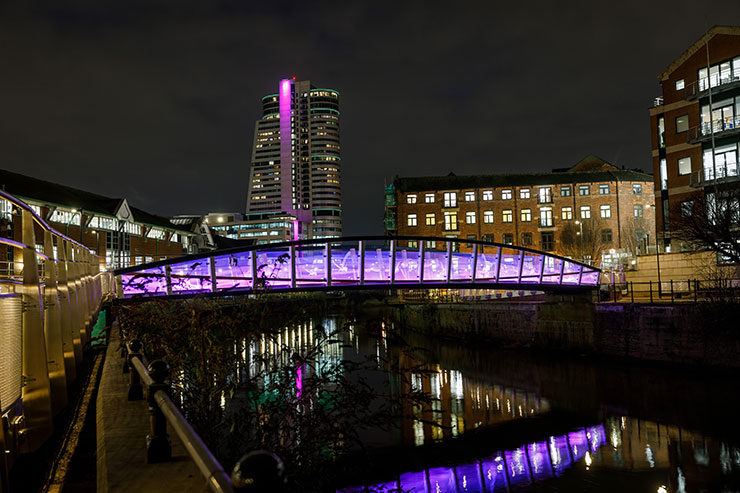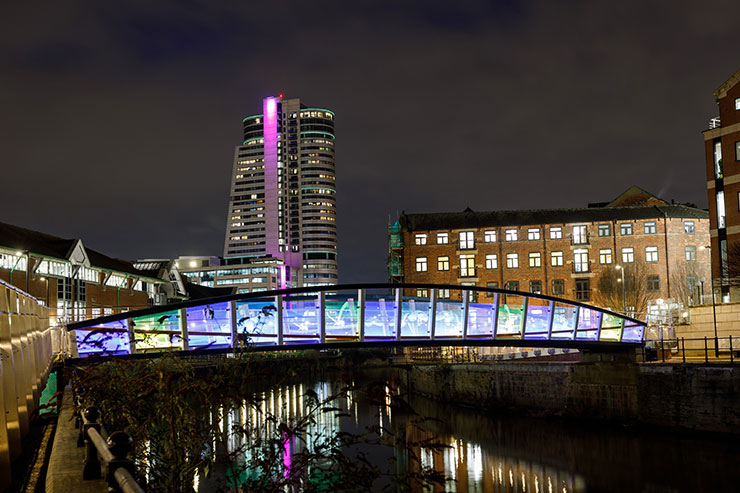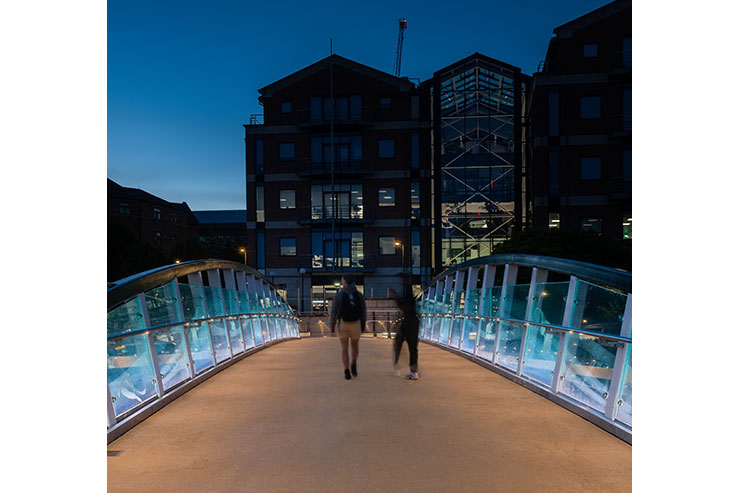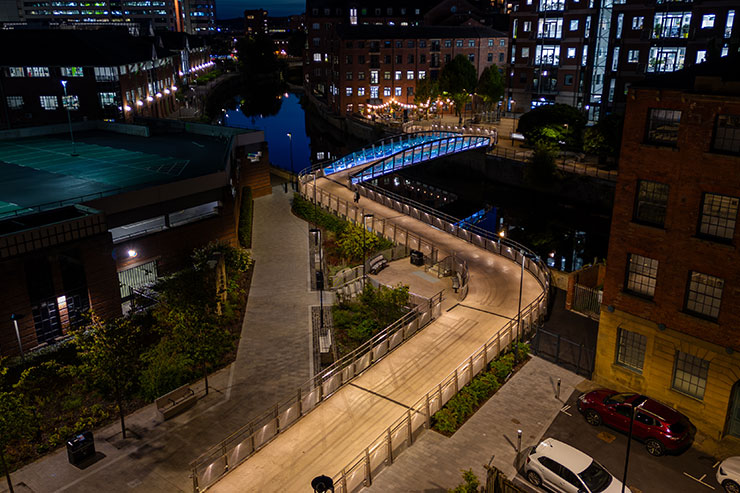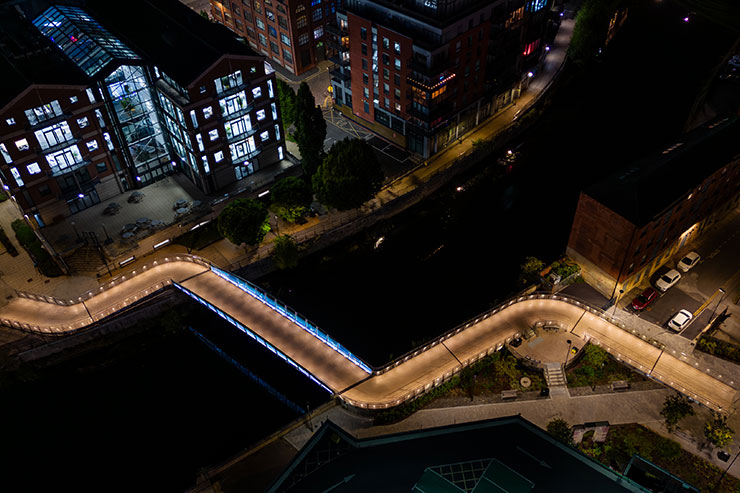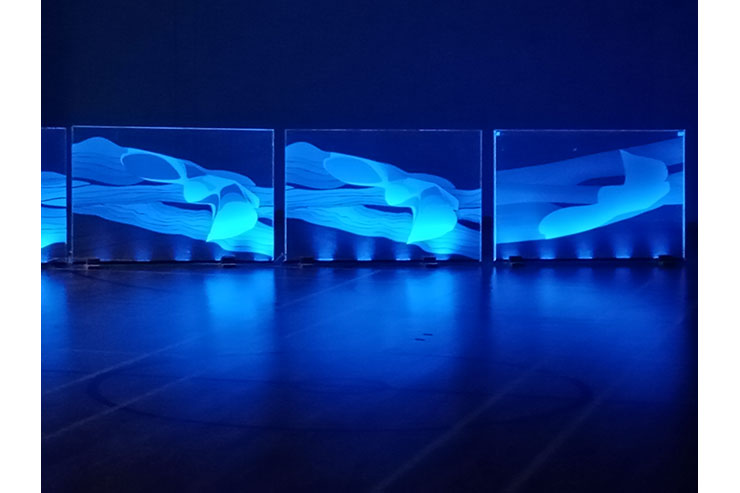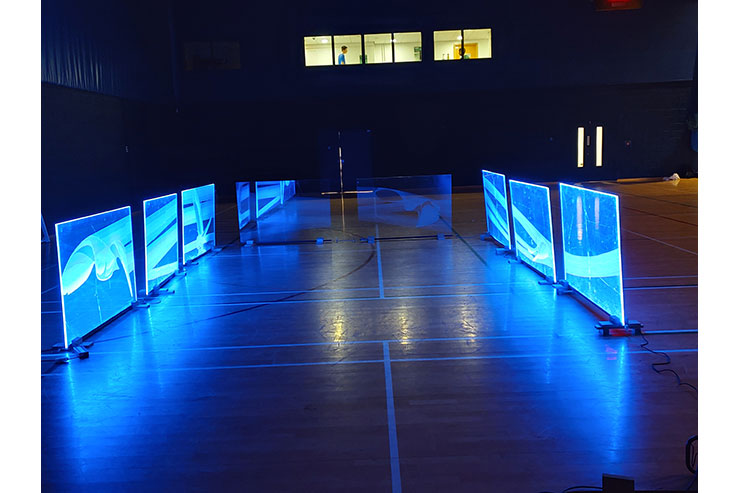- ABOUT
- JUDGING
- CONTACT
- MORE
- 2024 Entries
- Installations 2024
- Past Winners
- Subscribe
- [d]arc directory
- arc magazine
- darc magazine
David Oluwale Bridge, UK
ProjectDavid Oluwale BridgeLocationLeeds, UKLighting DesignMott MacDonald, UKAdditional DesignBAM: Nuttall | Landscape Architect: Planit.IEClientLeeds City CouncilLighting SuppliersDW Windsor, The LightLab
The David Oluwale Bridge (DOB) is a pedestrian and cycle bridge located to the south of Leeds city centre that opened in January 2023.
To demonstrate the city’s continuing efforts to recognise and integrate all parts of its community – and to create a lasting symbol of the commitment to diversity and inclusion – the bridge was named after the Nigerian-British citizen David Oluwale, who tragically drowned in the river in 1969 in a racially motivated incident.
The DOB project showcases how, through creative thinking and collaboration, it is possible to create beautiful, functional solutions that deliver active travel enjoyment, while at the same time producing sustainable outcomes.
For the project we effectively took the role of ‘lead creative designer’. To that end, we were able to tailor the forms of the bridge to work efficiently whilst delivering a unique lit environment after dark.
Our creative design thought process behind the design, in particular our desire to develop a strong narrative associated one that channelled the city’s much-loved Leeds Owl. Leeds City Council’s initial intention was to create a structure that promoted social cohesion with a strong cultural attachment to the city.
The project brief ‘discovery’ phase defined the need for an aesthetically pleasing structure which offered safe access for all users day and night whilst complying with challenging constraints.
We worked together to develop a solution that provided the best level of safe access practicable day and night-time within the limited site extents. Our stakeholder engagement works also included a significant period studying the site’s biodiversity with the ecology consultant and local authority planning team. Preserving the dark corridor was, naturally, a priority.
The bridge design intent was to deliver a decluttered structure, one where horizontal and vertical structural and ancillary lines were kept to a minimum. The lighting installation had to be recessive, so to ‘disappear’ during daytime and ‘reveal’ the bridge as a new user experience at night.
Once the site lighting baseline was optimised and defined, we were able to develop a unique lighting solution using industry-standard guidelines and obtrusive lighting mitigation recommendations combined with our in-house multidisciplinary creative thinking.
A Vierendeel bridge form with a very thin construction depth was developed. A glass parapet solution was provided to enhance the appearance of the bridge.
The inclusive users access strategy included the requirement for dual sided continuous handrails along the ramps and bridge. These consistent horizonal lines through the entire project provided a real value opportunity to integrate discreet point light sources. This approach has ensured all areas of the walkway surface are uniformly illuminated while also mitigating glare and environmental light spill.
The use of uniform lighting, in turn, assists those bridge users with adaptive difficulties. The light colour finish of the bridge deck then provides reasonable reflectance characteristic to support the vertical illuminance along the route, which enhances the feeling of safety. We worked with DW Windsor to fully integrate its ‘Garda’ handrail range to this project.
The glass balustrade surfaces provided an ideal canvas for creative manifestations. Our client requested us to develop a bespoke artwork solution that would represent the social value of the bridge, the identity of the city and be a showcase after dark.
The city of Leeds is well known for its iconic owl. There are three owls on Leeds City Council’s coat of arms, there are enormous golden owl statues outside Civic Hall, sculptures and paintings of owls at 24 other locations around the city, all of which are part of the ‘Leeds Owl Trail’.
However, these municipal representations are always of a static, perched bird. Our lighting designers wanted instead to connect the images of the bird with a children’s book about friendship and togetherness involving a flying owl, as these values, naturally, were important to our client.
This led to the development of the ‘dynamic flight’ concept and motif that has become integral to the bridge, and lighting design. It has been about using the city icon and combining it with the story to develop an art concept based on ‘positive energy, movement and life’.
The iconic Leeds Owl has therefore become no longer a static bird but a flying nocturnal specie along the bridge after dark, with the artwork concept revealing the owl at night-time as part of the bridge crossing experience. We worked with manufacturer The Light Lab to develop the balustrade graphic, integrate the luminaires, supply glass panels and supply and commission a lighting control.
A dot matrix graphic approach was chosen to manifest the artwork along the bridge. The process included etching dot patterns between the two panes of glass making each of the balustrade panel. Each balustrade was then to be bottom-edge lit to reveal the pattern at night.
A two-stage lighting physical mock-up of the balustrade, pattern etching and lighting was used to test out different solutions at small-scale.
The first stage aimed to test the dot matrix pattern density, reject the least effective proposals and witness from a distance the effect of superimposed patterns, as the feature balustrade is on both sides of the bridge. This latter experimental activity was important to ensure that the patterns were perceived as intended and not visually interfered by the Moiré effect, or the mechanical interference of light by superimposed networks of lines.
The second stage of the mock-up was to present the etching patterns, lit effects to the stakeholders and agree light scenes.
The dot matrix design enables the patterns to be discreet during daytime ensuring high transparency through the balustrade. At night-time, the patterns reflect the light emitted by linear light fixtures integrated to the bottom edge of the glass balustrade. This approach creates a pleasant contrast and visual comfort.
Finally, we developed a lighting control strategy to enable our client to theme the bridge at night-time throughout the year so as to be able to celebrate local, national or international events and seasonal festivities. The bridge now features as a permanent sustainable lighting asset for the annual Light Night in Leeds.
